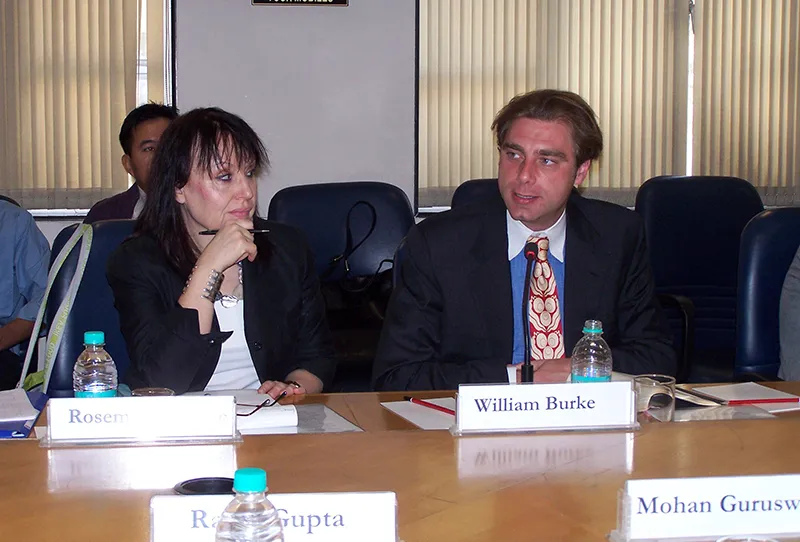There has been a relative decline in the far reaching capabilities of the US

The coming transition of political and economic power from west to east along with the threat of lack of coherence and direction during the same period was emphasised upon in a workshop on Global Governance in 2025 held at the ORF campus on, Tuesday, March 9, 2010.
Unlike historical precedents which suggests that redistribution of power tends to be accompanied by contests and conflicts of competing nations or by a lassitude in international relations which, in absence of clear leadership caused strategic lacunae in which potential for conflicts emerged, the current situation is different because of the presence of evolved international institutions and regimes which are more acceptable thus reducing the threat of a conflict, the workshop felt .
There has been a relative decline in the far reaching capabilities of the U.S. However, military power and technological superiority has still remained in the west, the workshop said.
The interaction was a part of the joint US-EU project, co directed by the US’ National Intelligence Council (NIC) on the assessment of the needs, challenges and opportunities in the shaping global governance architecture in the next 10 to 15 years. The NIC had in its previous projects outlined a list of relative certainties and list of relative uncertainties. On the top of certainties is the shift of political and economic power
The basic themes of the workshop included
• Assessment of new international agenda, analysis of old and new issues, perceptions and aspects of international cooperation
• Adaptation which included collective action, identifying and removing gaps and discrepancies, upcoming challenges and available competencies , possible regimes and frameworks
• Innovation like proliferation of formal groupings like G20 and other institutions
• Scope of institutional failure, increasing irrelevance of some frameworks
• Power and power structures which would cover emerging powers, groups and principles of sovereignty
• Role of non state actors including positive engagement, accountability, legitimacy and role of transitional non state actors
CHALLENGES:
It was stated that governance was a matter of the state and the way forward was global cooperation for peace and stability. Several challenges to global governance were outlined, and it was mentioned that some would go beyond traditional issues. These included climate change, resource depletion, demographic issues, energy scarcity and governance gaps. It was mentioned that rising living standards had led to an increased pressure on the resources and that there had been a struggle for raw materials in countries especially in Asia and Africa. It was also said that there would have to be a revolutionary change in rapid transport systems as growth had been dependent on mobility. Citing the need for equitable sharing of resources, it was said that limits to development would be enforced by hard resource constraints. Questions were raised on the IPR regime and new technology and serious concerns were expressed over the downward trend in investment in R&D and conventional energy.
Challenges on the strategic front included unilateralist manner of Chinese posturing, U.S approach to Afghanistan and Iran which were labeled ‘quantitative’ instead of ‘qualitative’ and the shift of power from democratic to more dictatorial regimes which had managed to deal with issues like the recent economic downturn better thus promoting the idea of a result based state rather than a value based one were mentioned.
Outlining the need for strategic thinking for common analysis of probable outcomes, the lack of systems to provide independent strategic thinking was lamented and inclusion of the aspect of global governance in monitoring and verification of national measures was explored.
SECURITY:
In the context of global security it was stated that the questions of foreign policy had become complicated and constraining and whether there would be a multipolarity, multilateralism, unilateralism or assertiveness by a coalition drawn together episodically by occasional coincidence of interests was unclear.
It was mentioned that the dangers of transition were not risks of outright conflict as were lack of coherence or direction, and that the example of the same was the inability to establish a regional security architecture in the Asia pacific despite repeated attempts and that the regional security architecture tended to reflect a settled distribution of power, which in the context of Asia when viewed from U.S interests would be the incentive to institutionalize and bring China in the ambit, but from the Chinese perspective would be to steer clear of any such arrangement with smaller states tending to look on in apprehension.
It was further mentioned that American agenda had been very ambitious and positive however not much had been achieved and that its political structure was too thinly spread for decisive political action abroad. It was however, mentioned in the same context that American aggregate capabilities were enormous and there had been an agreement across a broad spectrum on studies predicting a scenario of U.S reinventing itself in the years to come. A need for omniscience and for institutions to regenerate their military thinking was outlined. It was also said that there needed to be a focused discussion on soft power and that soft power not backed by military strength would not be realistic.
Citing that threats to global security would include transnational ones it was mentioned that countries like Turkey, Iran and Indonesia would also have major roles to play
INDIA AND ASIA:
A glaring lapse because of the absence of a security architecture in South Asia was indicated, it was however mentioned that Indian attachment to multilateralism would be measured and that Indian foreign policy was going to be driven by, an independent thinking that was historically informed, a stringent regional security environment and a sense of justice of international institutions and regimes.
It was further mentioned that even though it was common knowledge that present Chinese economic and military growth far exceeded India’s, it was not viable for political acceptance. Deftness of Indian diplomacy and way in which India had leveraged Chinese and American apprehensions and extracted strategic benefits for itself from each was commended.
It was predicted that China had no wish to assume the onerous burden of leadership Citing that a U.S-China duopoly would not be in Indian interests, it was said that India finds more in common with the west than with China and therefore compartmentalizing both would not be favourable and that U.S engagement in India needed to be a structured institutional response.
It was concluded that regional architecture in Asia would depend on how global architecture adapted to the power shift and that one of the institutional responses should be to strengthen the region and establish a zone of mutual cooperation
INSTITUTIONS, ALLIANCES, NETWORKS:
Pointing out to the existing gross inadequacy of International organizations, it was mentioned that if U.N failed to keep pace with the changes it could become problematic.
Strong views were expressed on the inability of UNSC to contribute to conflict resolution and the increasing irrelevance of other branches of U.N. It was mentioned that though the likelihood of India being granted the permanent membership of the Security Council was less India should continue to pursue it. Organizations like SCO which had fallen victim to disagreements between Russia and China with divergent interests and motives, ASEAN and APEC were also mentioned in the same context. It was mentioned non state actors like Greenpeace would play an important role.
There were questions on European and American stand on what India perceived as their core values and key future alliances and whether institutions and regions possessed the ability to adapt to then change and yet remain unchanged in their fundamentals
It was said that the G20 has been a hopeful innovation but there was uncertainty over its future and the extent to which its mandate would be broadened, possibility of linking its present structure with the U.N was also discussed. It was said that the existing institutions were created for a specific time and context and today the issue of mutuality of benefit should be added.
It was mentioned that India would prefer a restructured IMF than an Asian Monetary Fund dominated by China and it also welcomed a defined and active role of the European Union while acknowledging the continual presence of U.S as major player in Asia in the years to come.
.
The workshop was attended by delegations from the U.S department of state including Mr. William Burke white, representatives from NIC including Mathew J Burrows, representatives from the E.U and Transnational Policy Network Mr. James Elles and Mr Adam Ward from IISS, London among others.. Senior Faculties from ORF were also in attendance.
The report has been prepared by Akhilesh Variar, Research Intern, ORF
The views expressed above belong to the author(s). ORF research and analyses now available on Telegram! Click here to access our curated content — blogs, longforms and interviews.




 PREV
PREV

